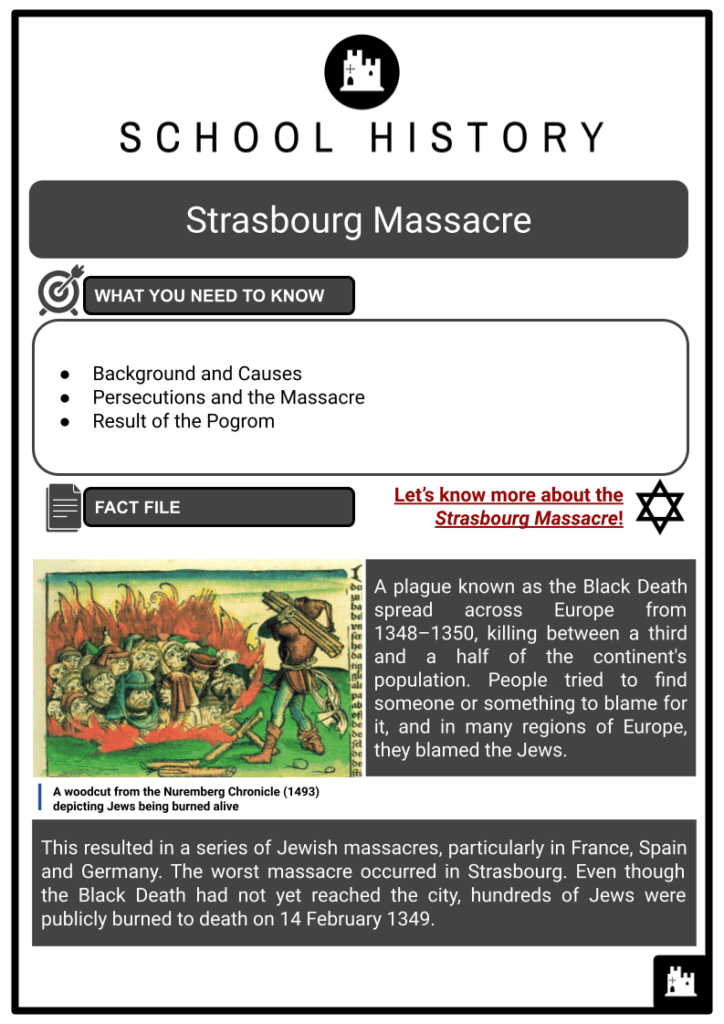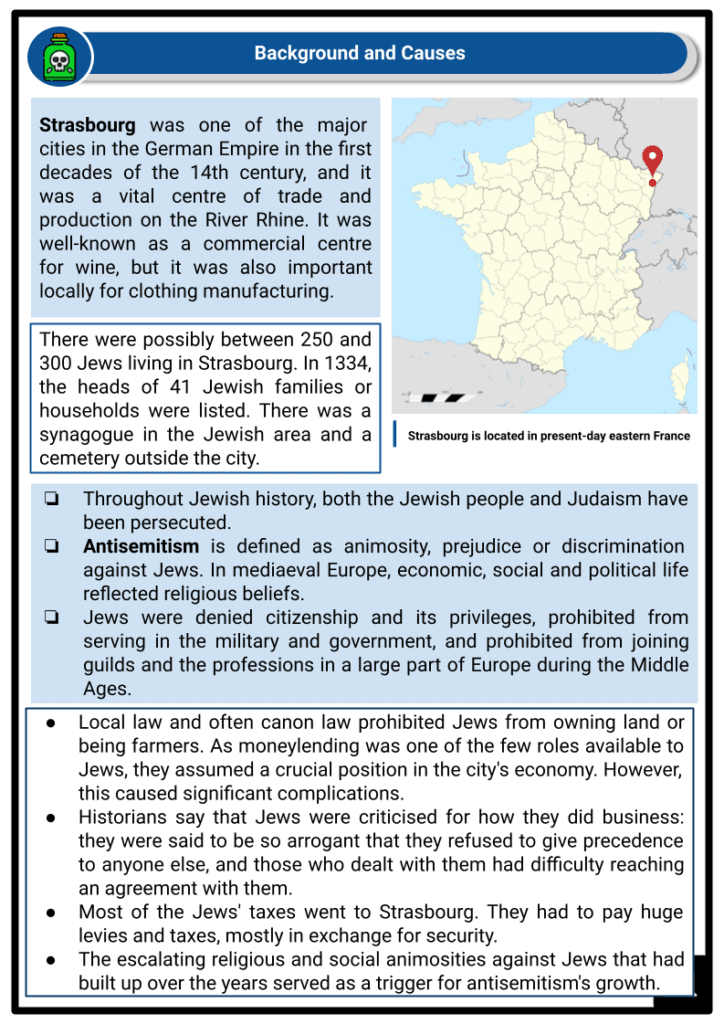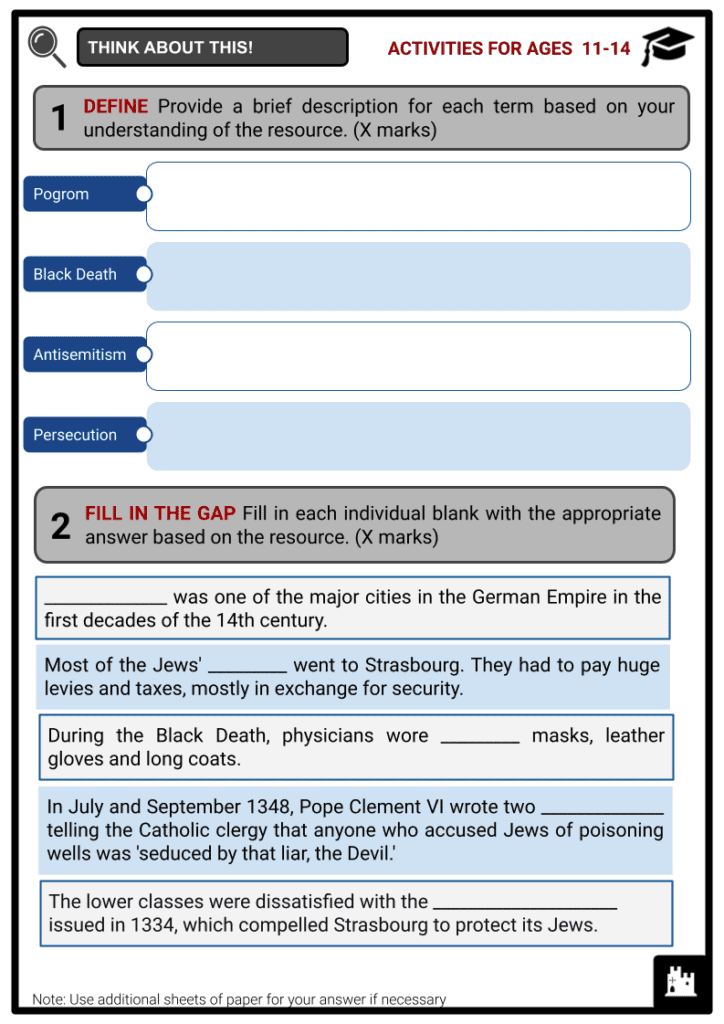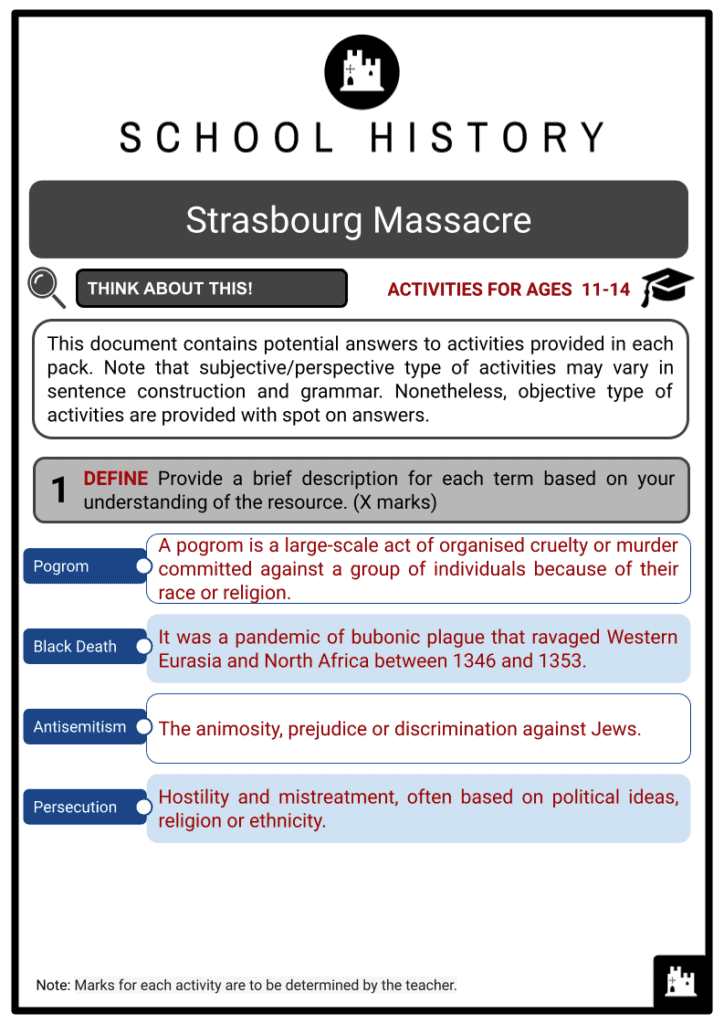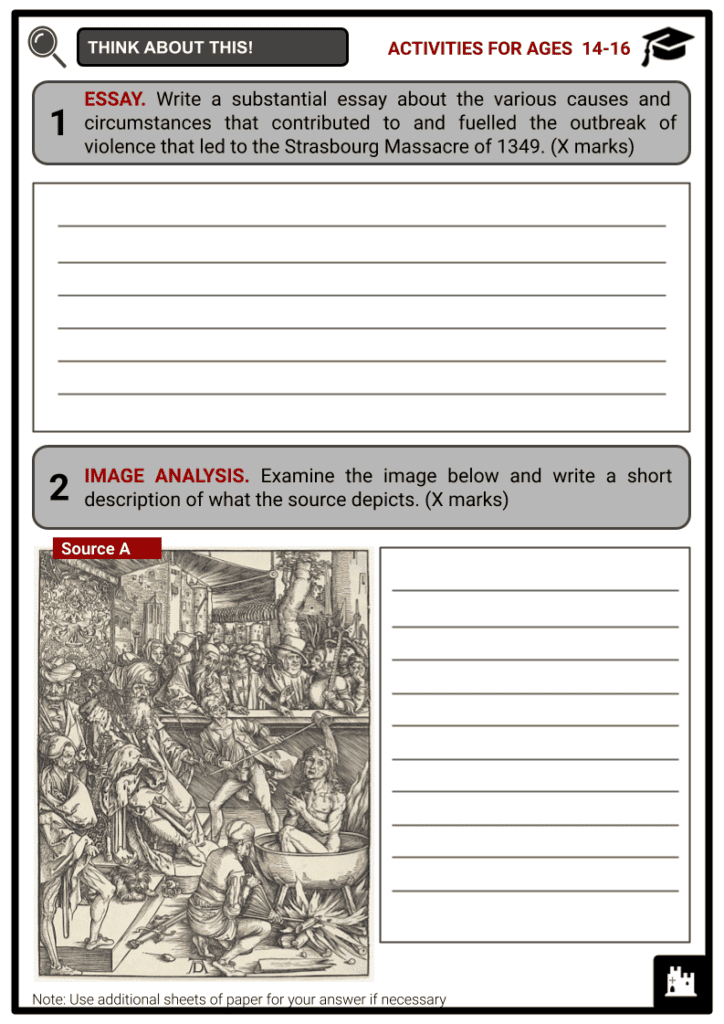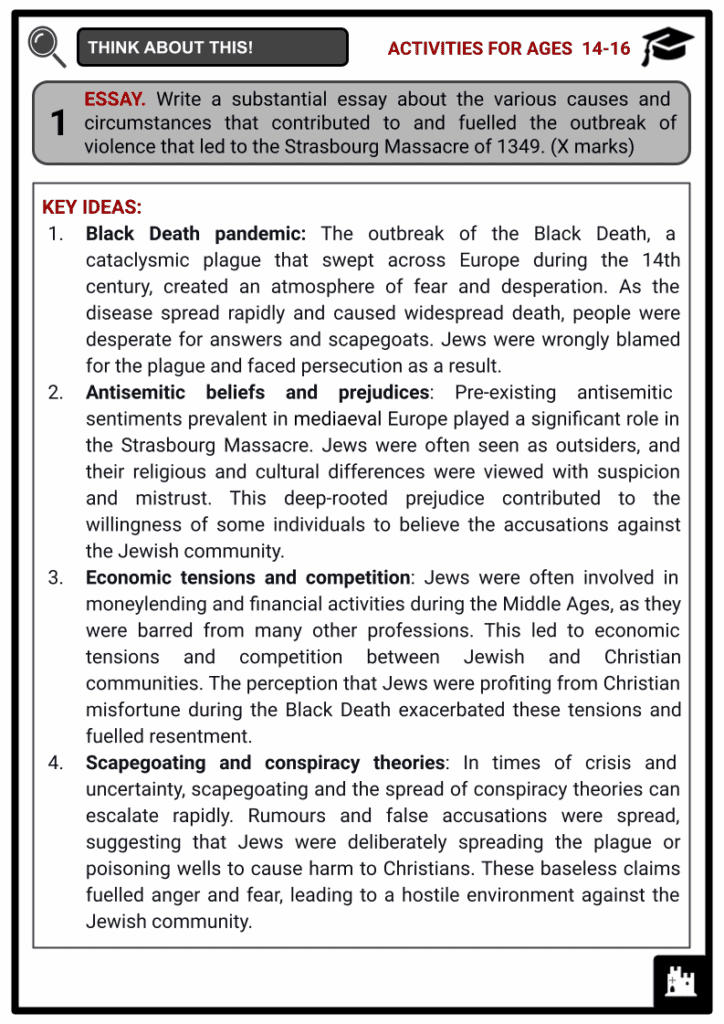Strasbourg Massacre Worksheets
Do you want to save dozens of hours in time? Get your evenings and weekends back? Be able to teach about the Strasbourg Massacre to your students?
Our worksheet bundle includes a fact file and printable worksheets and student activities. Perfect for both the classroom and homeschooling!
Summary
- Background and Causes
- Persecutions and the Massacre
- Result of the Pogrom
Key Facts And Information
Let’s know more about the Strasbourg Massacre!
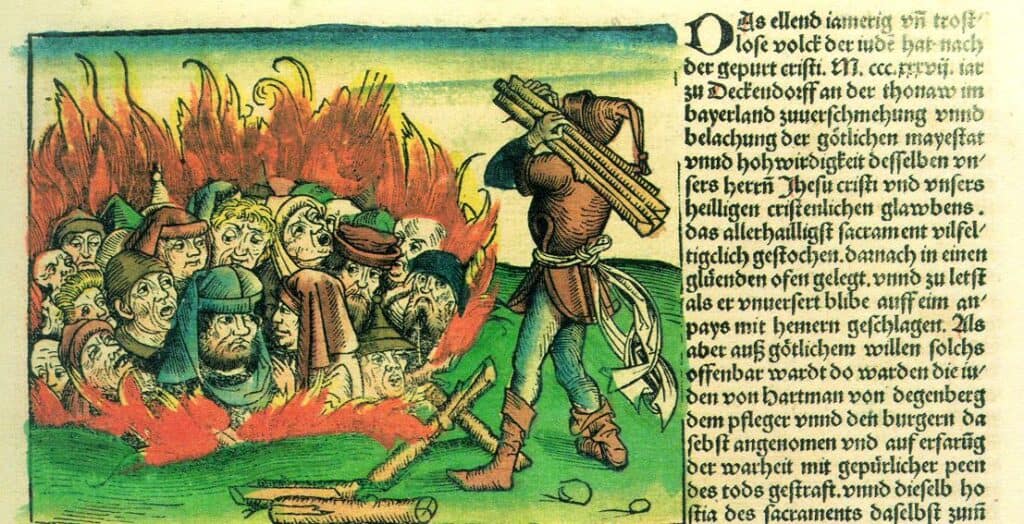
A plague known as the Black Death spread across Europe from 1348–1350, killing between a third and a half of the continent's population. People tried to find someone or something to blame for it, and in many regions of Europe, they blamed the Jews. This resulted in a series of Jewish massacres, particularly in France, Spain and Germany. The worst massacre occurred in Strasbourg. Even though the Black Death had not yet reached the city, hundreds of Jews were publicly burned to death on 14 February 1349.
Background and Causes
- Strasbourg was one of the major cities in the German Empire in the first decades of the 14th century, and it was a vital centre of trade and production on the River Rhine. It was well-known as a commercial centre for wine, but it was also important locally for clothing manufacturing.
- There were possibly between 250 and 300 Jews living in Strasbourg. In 1334, the heads of 41 Jewish families or households were listed. There was a synagogue in the Jewish area and a cemetery outside the city.
- Throughout Jewish history, both the Jewish people and Judaism have been persecuted.
- Antisemitism is defined as animosity, prejudice or discrimination against Jews. In mediaeval Europe, economic, social and political life reflected religious beliefs.
- Jews were denied citizenship and its privileges, prohibited from serving in the military and government, and prohibited from joining guilds and the professions in a large part of Europe during the Middle Ages.
- Local law and often canon law prohibited Jews from owning land or being farmers. As moneylending was one of the few roles available to Jews, they assumed a crucial position in the city's economy. However, this caused significant complications.
- Historians say that Jews were criticised for how they did business: they were said to be so arrogant that they refused to give precedence to anyone else, and those who dealt with them had difficulty reaching an agreement with them.
- Most of the Jews' taxes went to Strasbourg. They had to pay huge levies and taxes, mostly in exchange for security.
- The escalating religious and social animosities against Jews that had built up over the years served as a trigger for antisemitism's growth.
Black Death
- The Black Death (also known as the Pestilence, the Great Mortality, and the Bubonic Plague) was a pandemic of bubonic plague that ravaged Western Eurasia and North Africa between 1346 and 1353. It is the deadliest pandemic recorded in human history, killing between 75 and 200 million individuals at its peak in Europe between 1347 and 1351.
- In an effort to combat the disease during the European plague in the 16th and 17th centuries, physicians wore beaked masks, leather gloves and long coats. People thought that these clothes could purify poisonous air.
- Because 14th-century healers and governments didn't know how to stop or explain the disease, Europeans looked to astrological forces, earthquakes and Jews poisoning wells as possible causes.
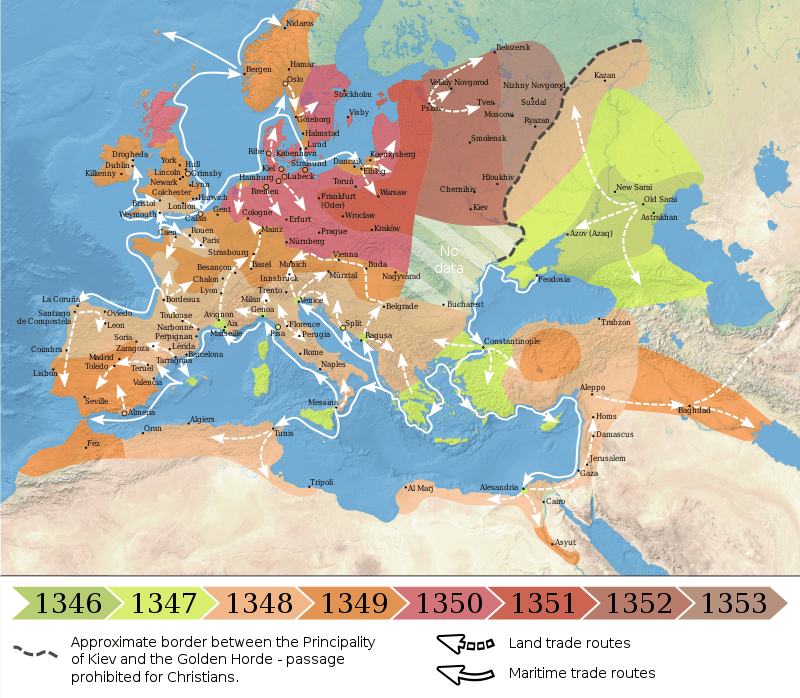
The Black Death spread throughout Europe, North Africa and the Near East - Many people believed that the outbreak was God's punishment for their sins, and that they could be relieved by obtaining God's forgiveness.
- With the looming threat of the Black Death, accusations of poisoning wells and explicit calls for the burning of Jews emerged.
Reports that caused hysteria
- Reports that Jews were polluting water sources first reached Strasbourg in the autumn of 1348, when the city council received letters from at least nine different locations.
- According to reports, the Bernese councillors sent one of their captive Jews to Strasbourg as further evidence of the veracity of their reports. All of this demonstrated the magnitude of the hysteria surrounding the impending pandemic.
- Unlike the mass of the public, the council and master tradesmen remained devoted to defending Jews and worked to calm the people down and prevent a pogrom.
- A pogrom is a large-scale act of organised cruelty or murder committed against a group of individuals because of their race or religion.
- In July and September 1348, Pope Clement VI wrote two papal bulls telling the Catholic clergy that anyone who accused Jews of poisoning wells was 'seduced by that liar, the Devil.'
- Despite these reports of Jewish duplicity in poisoning water sources, some local governments certainly considered that the accounts were questionable and warned against taking them seriously.
- On 12 January 1349, the city council of Cologne, for example, wrote to the leaders of Strasbourg, urging them to take control and for restraint to be used in the face of rising hysteria. It warned that Jewish persecution could spark widespread unrest.
- Unfortunately, a series of incidents prompted Strasbourg residents to disregard such warnings. Kenzingen, a town south of Strasbourg, indicated in its report on the Jewish probe that the Jews of Strasbourg were implicated in poisoning water sources and befouling them in numerous locations.
- These Jews, who were probably tortured, said clearly that the 'Jews who were in Strasbourg' were obviously involved.
- Without a doubt, such accusations contributed to the city of Strasbourg's growing hatred of Jews.
Persecutions and the Massacre
- When Strasbourg's city leaders initially protected the Jewish community, they insisted that their Jews were not guilty of the crimes that had been blamed on them in other places.
- In January 1349, a council was held at the Alsace town of Benfeld, south of Strasbourg, attended by the bishop of Strasbourg, lords, barons, and representatives from the region's different communities. When the Strasbourg diplomats stated that they were unaware of any Jewish conspiracy, the other representatives questioned them.
- Since the entire populace railed against the Jews, the bishop of Strasbourg, the lords of Alsace, and the representatives from the imperial towns refused to continue tolerating them. The highest powers in the region then granted official approval for the Jews' destruction.
- The most influential people in Alsace had clearly withdrawn their protection from the Jews, indicating that attacks were imminent. The major reason for this shift in attitude presumably had little to do with the people's cries. The men at the Benfeld council realised that if their creditors were eliminated, they would be able to pay off their debts to Jewish moneylenders.
- The removal of Jewish protection allowed large-scale attacks, and many locations most likely took advantage of this vulnerability to attack Jewish communities in their areas. Soon, the Jews were burned and killed in one place after another.
- The lower classes were dissatisfied with the Letter of Consolation issued in 1334, which compelled Strasbourg to protect its Jews.
- Workers were equally enraged that the city's leaders continued to defend the Jewish community in 1349. In that year, the mayor of Strasbourg, Peter Swarber, and his assistant mayors, Konrad von Winterhur and Gosse Sturm, refused to consent to the extermination of the Jews, a position that was undoubtedly strengthened by his concern for the city's economic development.
- These leaders fought to protect the Jewish community, and city workers directed some of their anger towards the mayor and his subordinates. Many people suspected that these individuals had been bribed by Jews in order to gain protection.
- On 9 February, the guilds marched to the church in the centre of Strasbourg, which was where the government was. This wasn't a spontaneous act or a mob, because the action showed signs of being carefully planned. The people advanced with their weapons and banners. They appear to have been deployed in the same manner as when the city militia was called out for a campaign.
- The noble houses of Zorn and Müllenheim, who had been ousted from power at the time, attempted to reclaim their former position by cooperating with the guilds.
- The mayor and his two assistants were removed from their positions by the guilds and nobles, and the mayors granted them the city seals, which served as a symbol of authority.
- Through the revolt, the old noble families regained a substantial portion of their former power, the guilds' political participation was restored, and many anticipated that the new political leadership would adopt an antisemitic stand.
- 10 February 1349, the day following the removal of the mayors, saw the election of new municipal officials.
- The city's new authorities were not concerned about either the contract of protection with the Jews or the financial damages caused by the pogrom. The two deposed officials were tasked with leading the Jews to their execution site while claiming to lead them out of Strasbourg.
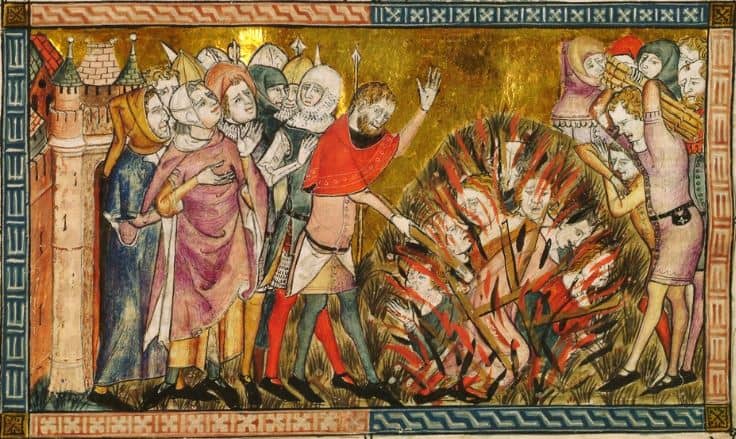
A contemporary drawing of Jews being burned to death during the Black Death persecutions - A wooden hut had been built, in which the Jews were burned alive on Saint Valentine's Day, Saturday, 14 February 1349.
- Those Jews willing to be baptised, as well as children and attractive women, were spared from being burned alive. The massacre is believed to have lasted six days.
Result of the Pogrom
- After killing the Jews, the murderers divided the property among themselves, implying another reason for the killings. The debtors had the option to recover themselves by killing the Jews, which they made use of on a regular basis. Many of those who advocated for the uprising owed money to Jews, demonstrating the link between the overthrow of the master traders and the pogrom.
- Apart from Strasbourg nobility and citizens, Bishop Berthold von Buchegg, some landed gentry, and even several sovereign monarchs, such as the Margrave of Baden and the Count of Württemberg, owed money to the Jews. The council decided to split the Jews' money among the artisans as a reward for their assistance in overthrowing the master tradesmen.
- On 5 June 1349, Strasbourg formed an alliance with the bishop and the Alsatian nobility, promising to repay all bonds and receiving assurances that the bishop and nobles would support Strasbourg against anyone seeking to hold it accountable for the murder of Jews and confiscation of their assets. The Strasbourg council urged that its allies take action against Jews as well.
- Attacks against Jews occurred in hundreds of German towns and cities, and the untold number of casualties was likely in the thousands. The survivors frequently had to run for their life. A few Jews were permitted to return to several of these villages in the next decades, although their numbers were considerably smaller than before. In actuality, towards the end of the 14th century, just a few large Jewish centres remained in Germany.

